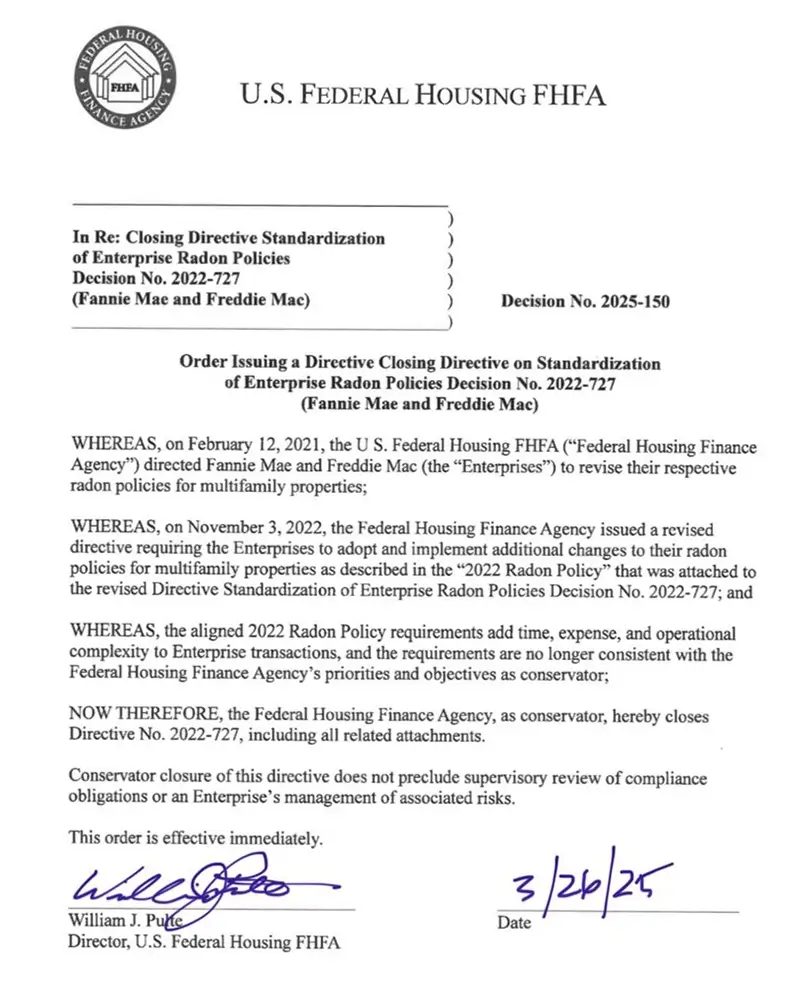What Were the 2023 Radon Requirement Changes?
In 2023, the Federal Housing Finance Agency (FHFA) issued a directive requiring Fannie Mae and Freddie Mac to standardize radon testing across all multifamily properties financed through the Enterprises. The resulting Enterprise Multifamily Radon Policy established a uniform national standard for testing and mitigation. Under that policy, 25 percent of ground-contact residential units at every Enterprise-backed property were required to be tested for radon, regardless of location or local risk levels.
The rule was intended to bring consistency to radon management across federally backed multifamily housing, and ensure safe living conditions for current and future residents.
What Changed in 2025?
On March 26, 2025, the FHFA rescinded the 2022-727 directive that created the standardized radon policy. The new order states that the previous requirements added “time, expense, and operational complexity to Enterprise transactions” and were “no longer consistent with the Federal Housing Finance Agency’s priorities and objectives as conservator”.

With this action, the FHFA effectively ended the nationwide testing mandate for Enterprise-backed multifamily properties. While the closure removes the standardized testing requirements, the agency retained the ability to review compliance or risk management practices as needed under its supervisory authority. The order took effect immediately upon signing.
Changes to Fannie Mae and Freddie Mac’s Radon Requirements
Following FHFA’s change, both Enterprises issued new guidance revising their multifamily radon policies:
Fannie Mae (April 2025 Guide Update):
Freddie Mac (May 2025 Guide Bulletin):
These changes effectively return radon testing requirements to pre-2023 levels, rolling back some of the progress made in recent years toward strengthening radon safety for new commercial and multifamily construction.
What This Means for Commercial Builders and Contractors
For builders and contractors involved in multifamily, mixed-use, or commercial residential projects, these changes mark a significant shift. The federal testing mandate has been lifted, but the responsibility for radon risk assessment remains.
In practice, the FHFA’s decision places greater emphasis on individual judgment and local compliance. Builders and environmental consultants should coordinate early with lenders to determine each project’s radon testing and mitigation expectations.
Professional Radon Testing and Mitigation
Although the FHFA has relaxed its national testing requirements, radon remains a serious environmental health concern, and managing it proactively is still the smart move for builders and contractors. Incorporating radon-resistant new construction techniques during the building phase is far more cost-effective than installing mitigation systems after occupancy. Preventive measures not only help protect future occupants but also ensure compliance with HUD, state, or lender-specific radon expectations if funding or resale involves federal programs.
By designing with mitigation in mind from the start, contractors and developers can reduce long-term risk, control costs, and deliver properties that meet modern health and safety standards. Contact Southwest Radon Eliminators to learn more about pre-construction radon planning and mitigation services.
